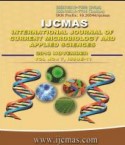


 National Academy of Agricultural Sciences (NAAS)
National Academy of Agricultural Sciences (NAAS)

|
PRINT ISSN : 2319-7692
Online ISSN : 2319-7706 Issues : 12 per year Publisher : Excellent Publishers Email : editorijcmas@gmail.com / submit@ijcmas.com Editor-in-chief: Dr.M.Prakash Index Copernicus ICV 2018: 95.39 NAAS RATING 2020: 5.38 |
Yeasts of the genus Candida have high genetic variability and are the most common opportunistic pathogenic, which isolated from clinical samples that cause many problems to human, frequently isolated from patient which had diabetes mellitus. The aims of study were Detection and isolation and identification of Candida spp. in Diyala province by routine laboratory procedures. A total of 100 cases between 20 and 90 years old, this study include patients have symptom of oral candidiasis in patient with diabetes mellitus, over a one month period (from December 2017 to February 2018), in Dialay Teaching Hospital. The oral swabs were for cultures on two media, the first media was used for primary isolation which was Sabouraud´s dextrose agar (SDA) media and the second was to differentiate Candida spp. according to their colours and also germ tube used for identification of C. albicans. Results of this study presented that the highest infection of the Candida spp was accounted for C. albicans 31 (55.35%) from the 56 (56%) positive cultures, while other species were as follows: appear Candida glabrata (12) (26.88%), Candida parapsilosis (6) (13.44%), Candida krusi (4) (8.96%), Candida tropical (3) (6.72%). Through the analysis of data that collected from patients, there were non-significant, relationships were found between Candida infection and age group, gender, smoking type of diabetic. But there was significant, relationship found between candida infection and family history. All data were statistically analyzed depending on SPSS (Statistical Package for Social Science) version 18 (2009) C. albicans is the most common isolated among the total Candida species, and Candida glabrata was the most frequent non–albicans species. In this study we found that patients with type II diabetes mellitus were more infected by Candida albican than type I.
 |
 |
 |
 |
 |